Hanwha Systems Bundle
How Did Hanwha Systems Rise to Global Tech Powerhouse?
From its humble beginnings to its current stature, the Hanwha Systems SWOT Analysis reveals a fascinating journey. This South Korean company, initially focused on defense, has dramatically expanded its scope. Its transformation offers valuable lessons for investors and business strategists alike.
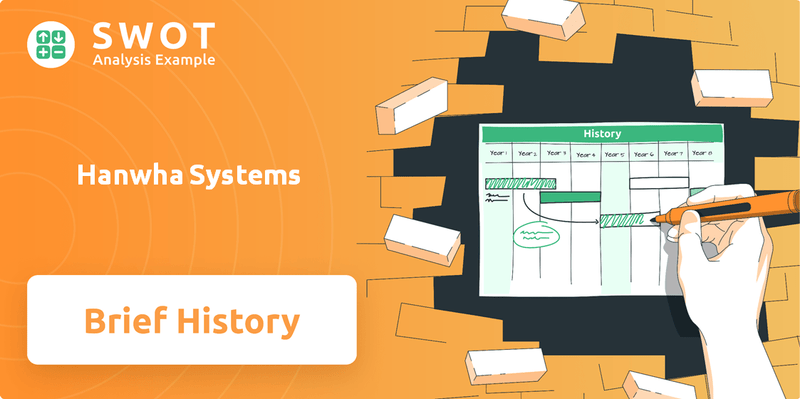
The brief history of Hanwha Systems company showcases a remarkable evolution. Starting in 1977, the company's strategic pivots and technological advancements have solidified its position. Understanding Hanwha's history is crucial for anyone interested in the defense industry or the broader technology sector. The company's story is a testament to innovation and adaptability.
What is the Hanwha Systems Founding Story?
The Hanwha Systems story began on August 1, 1977, with the establishment of Samsung Precision Co. Ltd. This marked the genesis of what would become a significant player in the South Korean company and defense industry.
The company's founding was rooted in Samsung's broader strategic moves within South Korea's evolving industrial sector. The initial focus was on addressing the need for advanced defense capabilities, crucial for the nation's post-war development. The company was designated as a first-class defense company in 1978.
Hanwha history is marked by its evolution and strategic partnerships, reflecting its growth and adaptation within the technology company landscape.
Key milestones shaped Hanwha Systems' trajectory.
- In 1986, the company achieved a significant milestone with the mass production of fire control equipment for Korean tanks and ships.
- The company's name changed to Samsung Aerospace Co. Ltd. in 1987, reflecting its expanding scope.
- A pivotal move occurred in 1999 when Samsung Electronics and Thales Group formed a joint venture.
- On January 11, 2000, Samsung Thompson CSF Co., Ltd. was launched, combining Samsung's industrial strength with Thales' expertise in defense technology.
Initial funding likely came from the Samsung Group's capital allocation for new ventures. This approach underscores the strategic investments made by the established company rather than typical startup funding rounds. The company's early focus on defense systems laid the groundwork for its future in the technology and aerospace industries.
Hanwha Systems SWOT Analysis
- Complete SWOT Breakdown
- Fully Customizable
- Editable in Excel & Word
- Professional Formatting
- Investor-Ready Format
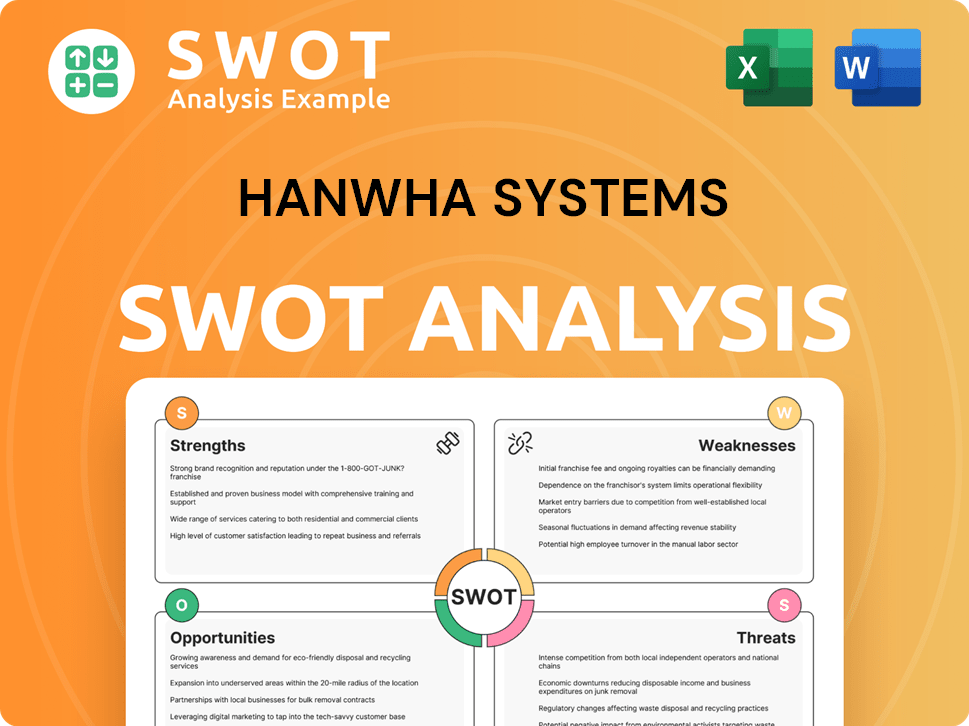
What Drove the Early Growth of Hanwha Systems?
The early growth and expansion of the Hanwha Systems were marked by strategic partnerships and a growing presence in defense technology. This South Korean company underwent several significant transformations, including name changes and mergers, which shaped its trajectory. The company's evolution reflects its adaptation to the dynamic demands of both the defense and IT sectors. This period was crucial for establishing its foundation and setting the stage for future advancements.
In 2001, the company was renamed Samsung Thales Co., Ltd., indicating a strategic partnership. During the 2000-2010 period, the systems division focused on development through foreign inducement. The ICT division, which spun off to Hanwha S&C, emphasized 'Customer Focus Value'.
Key developments included the completion of the IFF Mode 4 performance improvement project in 2000. In 2009, the company acquired CMMI Level 5 v1.2 Certification, a first for Korea in the systems sector. These milestones highlighted the company's commitment to technological advancement in the defense industry.
A pivotal moment occurred in 2014 when the company was sold to Hanwha Group. This acquisition led to a renaming as Hanwha Thales in 2015. The company was renamed to its current name, Hanwha Systems, in October 2016, marking a new chapter in its history.
In 2018, Hanwha Systems successfully launched as an integrated corporation, merging with Hanwha S&C, consolidating its defense and ICT businesses. The company's revenue in 2018 reached approximately 1.13 trillion KRW (about $1.13 billion USD). The establishment of the National Defense AI Convergence Research Center with KAIST in 2018 signaled a strategic shift towards advanced technologies and technology advancements.
Hanwha Systems PESTLE Analysis
- Covers All 6 PESTLE Categories
- No Research Needed – Save Hours of Work
- Built by Experts, Trusted by Consultants
- Instant Download, Ready to Use
- 100% Editable, Fully Customizable
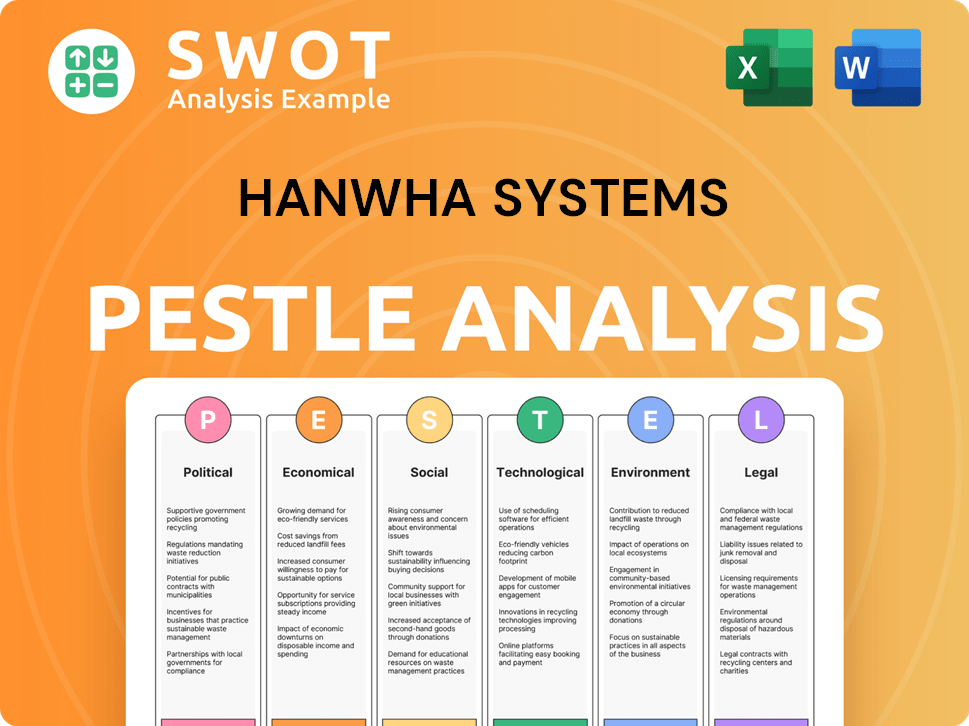
What are the key Milestones in Hanwha Systems history?
The Hanwha Systems has marked several significant milestones throughout its history, solidifying its position as a key player in the South Korean company and global technology landscape. The Hanwha history is marked by strategic expansions and technological advancements.
Empower with Milestones Table| Year | Milestone |
|---|---|
| 2016 | Launched the development of the AESA radar prototype for KF-21, demonstrating its commitment to the defense industry. |
| 2017 | Completed the development of the C2A (Command, Control, and Alert) system, enhancing its capabilities in defense electronics. |
| 2019 | Entered the Urban Air Mobility (UAM) market, becoming the first Korean company to do so, showcasing its innovative approach. |
| 2020 | Awarded the KDDX Combat System and Multifunction Radar Programs, further strengthening its role in advanced defense technologies. |
| 2020 | Acquired Phasor Solutions, a UK-based satellite communication antenna developer, and incorporated Hanwha Phasor. |
| 2021 | Invested USD 300 million in OneWeb, a UK-based space internet company, and joined its management board, expanding into space technology. |
Hanwha Systems has consistently pursued innovation, particularly in the Hanwha company's defense and technology sectors. The company's foray into the UAM market and its investments in space technology, such as OneWeb, highlight its forward-thinking strategy.
Hanwha Systems was the first Korean company to enter the Urban Air Mobility (UAM) market in 2019, demonstrating its commitment to future transportation solutions. This move positioned the company at the forefront of innovative urban mobility technologies.
The company invested USD 300 million in OneWeb and joined its management board in 2021, showcasing its strategic focus on space-based internet and communication technologies. This investment enhanced its portfolio with advanced satellite communication solutions.
The development of the AESA radar prototype for KF-21 in 2016 marked a significant advancement in radar technology. This innovation improved the capabilities of the defense systems.
The completion of the C2A (Command, Control, and Alert) system in 2017 enhanced the company's capabilities in defense electronics. This system improved the efficiency and effectiveness of defense operations.
Winning the KDDX Combat System and Multifunction Radar Programs in 2020 solidified its position in advanced defense electronics. This achievement enhanced its role in the defense sector.
The acquisition of Phasor Solutions and the incorporation of Hanwha Phasor in 2020 expanded its capabilities in satellite communication. This strategic move strengthened its technology portfolio.
Hanwha Systems has faced challenges common to the defense and IT sectors, including market fluctuations and intense competition. The company has responded with strategic adjustments, such as rebranding and focusing on new technologies.
The company has faced challenges related to market downturns in both the defense and IT sectors. These fluctuations require strategic adaptability and resilience.
Intense competition within the defense and IT industries poses ongoing challenges. The company addresses this through innovation and strategic partnerships.
The major rebranding from Hanwha Techwin to Hanwha Vision in March 2023 demonstrated a strategic pivot. This shift aimed to expand beyond traditional surveillance to a global vision solutions provider.
In 2024, Hanwha Systems reported a record-high annual operating profit of 219.3 billion won (approximately $151.5 million USD), a 79% increase from the previous year. Sales reached 2.8 trillion won (approximately $2.8 billion USD), up 14.3% year-on-year.
Net profit saw a significant increase of 29.8% to 445.2 billion won (approximately $445.2 million USD), reflecting the company's ability to overcome challenges. This financial performance demonstrates the company's resilience.
The company has adapted its strategies in response to market demands and technological advancements. This includes investments in future technologies and strategic partnerships.
For more in-depth information about the company's ownership and stakeholders, you can refer to this article: Owners & Shareholders of Hanwha Systems.
Hanwha Systems Business Model Canvas
- Complete 9-Block Business Model Canvas
- Effortlessly Communicate Your Business Strategy
- Investor-Ready BMC Format
- 100% Editable and Customizable
- Clear and Structured Layout
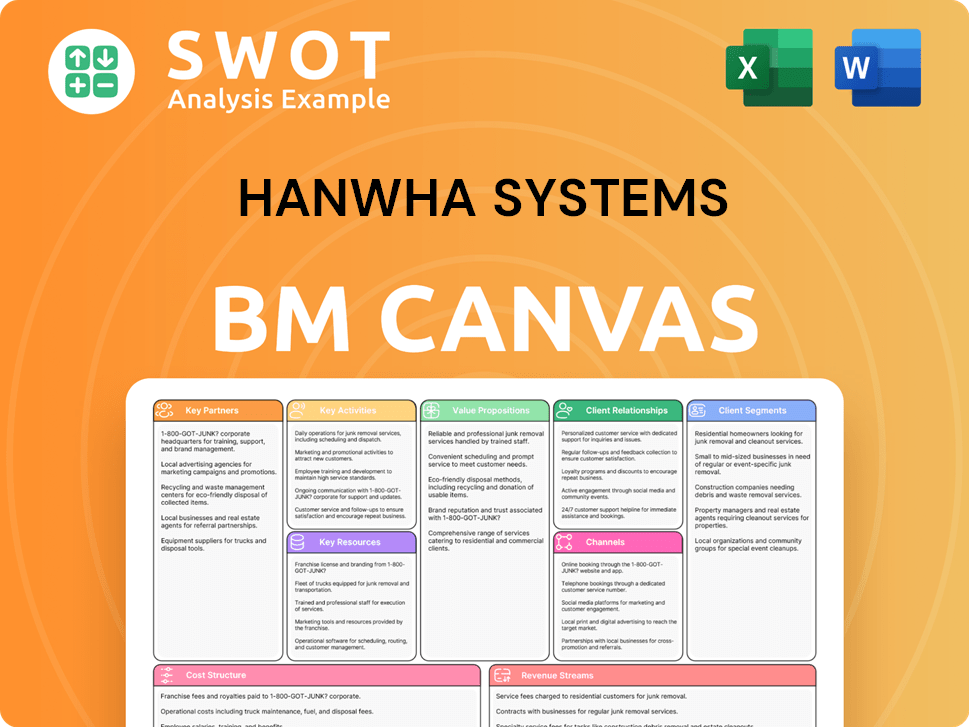
What is the Timeline of Key Events for Hanwha Systems?
The Hanwha Systems, a prominent South Korean company, has a rich Hanwha history marked by significant transformations and strategic expansions. Initially established as Samsung Precision Co. Ltd. in 1977, the company evolved through several name changes and strategic partnerships before becoming Hanwha Systems. This evolution reflects its growth and diversification in the defense industry and technology company sectors.
| Year | Key Event |
|---|---|
| 1977 | Founded as Samsung Precision Co. Ltd. |
| 1986 | Began mass production of fire control equipment for Korean tanks and ships. |
| 1987 | Renamed Samsung Aerospace Co. Ltd. |
| 1999 | Signed a joint venture contract with French Thompson CSF and Samsung Electronics. |
| 2000 | Launched as Samsung Thompson CSF Co., Ltd. |
| 2001 | Company name changed to Samsung Thales Co., Ltd. |
| 2014 | Sold to Hanwha Group. |
| 2015 | Renamed Hanwha Thales. |
| 2016 | Renamed Hanwha Systems. |
| 2018 | Merged with Hanwha S&C and established the National Defense AI Convergence Research Center with KAIST. |
| 2019 | Entered the Urban Air Mobility (UAM) market. |
| 2020 | Awarded KDDX Combat System and Multifunction Radar Programs; acquired Phasor Solutions (UK). |
| 2021 | Completed a paid-in capital increase of KRW 1.2 trillion (approximately $1.2 billion USD). |
| 2023 (March) | Hanwha Techwin rebranded as Hanwha Vision, focusing on next-generation vision solutions. |
| 2024 (February) | Reported record-high annual operating profit of 219.3 billion won (approximately $151.5 million USD) and sales of 2.8 trillion won (approximately $2.8 billion USD) for 2024. |
| 2024 (December) | Completed the acquisition of Philly Shipyard in the U.S. with Hanwha Ocean. |
| 2025 (1Q) | Reported sales of 690,101 million KRW (approximately $690 million USD) and operating income of 58,164 million KRW (approximately $58 million USD). |
Hanwha Systems aims to discover new overseas markets for its Multifunction Radar (MFR) systems and small Synthetic Aperture Radar (SAR) satellites. The acquisition of Philly Shipyard in the U.S. in December 2024, along with Hanwha Ocean, provides a strategic bridgehead for expansion into the U.S. ship market. This move underscores Hanwha's commitment to broadening its global footprint and enhancing its competitiveness in the defense sector.
Hanwha Vision expects generative AI to permeate both on-premise systems and edge AI cameras by 2025, enabling more intelligent video surveillance. Analyst predictions suggest the AI sector will grow from USD 638.23 billion in 2024 to USD 757.58 billion in 2025, potentially reaching USD 3.68 trillion by 2034. This growth highlights the importance of AI in Hanwha Systems' strategic initiatives.
The company plans to solidify its performance in 2025 by commencing the first production of the Korean fighter jet (KF-21) Active Electronically Scanned Array (AESA) radar. Hanwha Systems will continue exports of existing MFR systems. These efforts are crucial for maintaining its position in the defense industry and contributing to South Korea's technological advancements.
In the ICT sector, Hanwha Systems continues to provide IT solutions, integration, security, and digital transformation services. This ongoing commitment to providing IT solutions and services supports Hanwha's growth in the technology sector. The company's strategic focus on AI and digital transformation is expected to drive further innovation and expansion.
Hanwha Systems Porter's Five Forces Analysis
- Covers All 5 Competitive Forces in Detail
- Structured for Consultants, Students, and Founders
- 100% Editable in Microsoft Word & Excel
- Instant Digital Download – Use Immediately
- Compatible with Mac & PC – Fully Unlocked
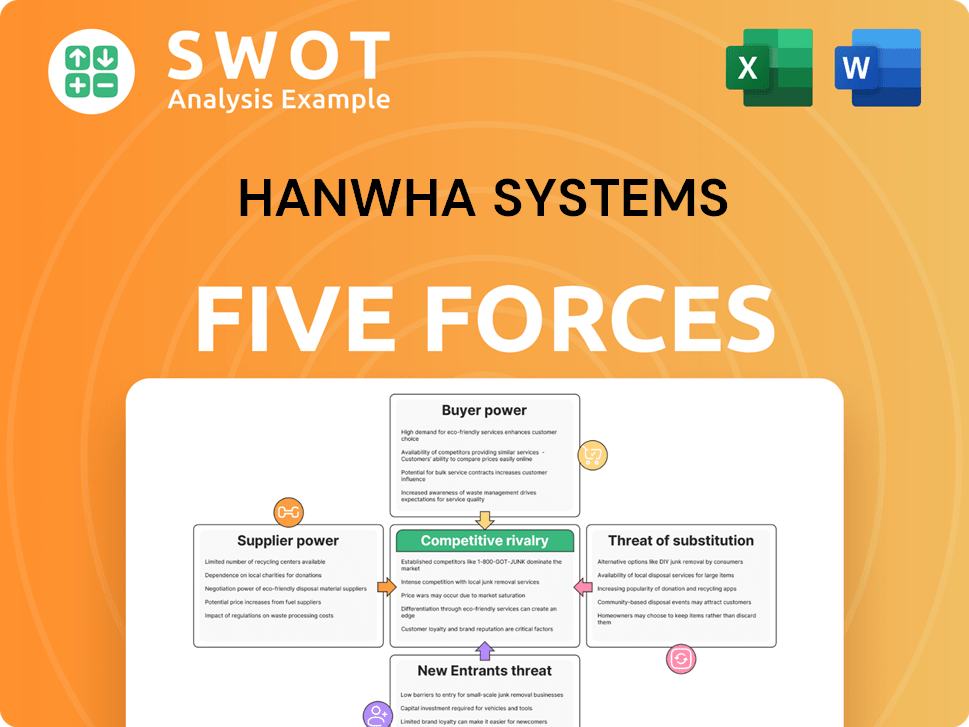
Related Blogs
- What is Competitive Landscape of Hanwha Systems Company?
- What is Growth Strategy and Future Prospects of Hanwha Systems Company?
- How Does Hanwha Systems Company Work?
- What is Sales and Marketing Strategy of Hanwha Systems Company?
- What is Brief History of Hanwha Systems Company?
- Who Owns Hanwha Systems Company?
- What is Customer Demographics and Target Market of Hanwha Systems Company?
Disclaimer
All information, articles, and product details provided on this website are for general informational and educational purposes only. We do not claim any ownership over, nor do we intend to infringe upon, any trademarks, copyrights, logos, brand names, or other intellectual property mentioned or depicted on this site. Such intellectual property remains the property of its respective owners, and any references here are made solely for identification or informational purposes, without implying any affiliation, endorsement, or partnership.
We make no representations or warranties, express or implied, regarding the accuracy, completeness, or suitability of any content or products presented. Nothing on this website should be construed as legal, tax, investment, financial, medical, or other professional advice. In addition, no part of this site—including articles or product references—constitutes a solicitation, recommendation, endorsement, advertisement, or offer to buy or sell any securities, franchises, or other financial instruments, particularly in jurisdictions where such activity would be unlawful.
All content is of a general nature and may not address the specific circumstances of any individual or entity. It is not a substitute for professional advice or services. Any actions you take based on the information provided here are strictly at your own risk. You accept full responsibility for any decisions or outcomes arising from your use of this website and agree to release us from any liability in connection with your use of, or reliance upon, the content or products found herein.